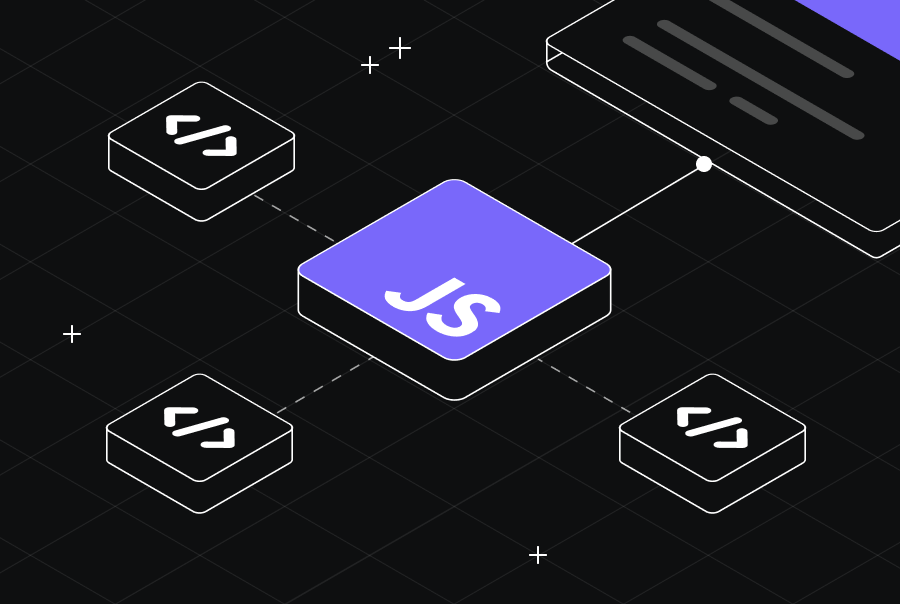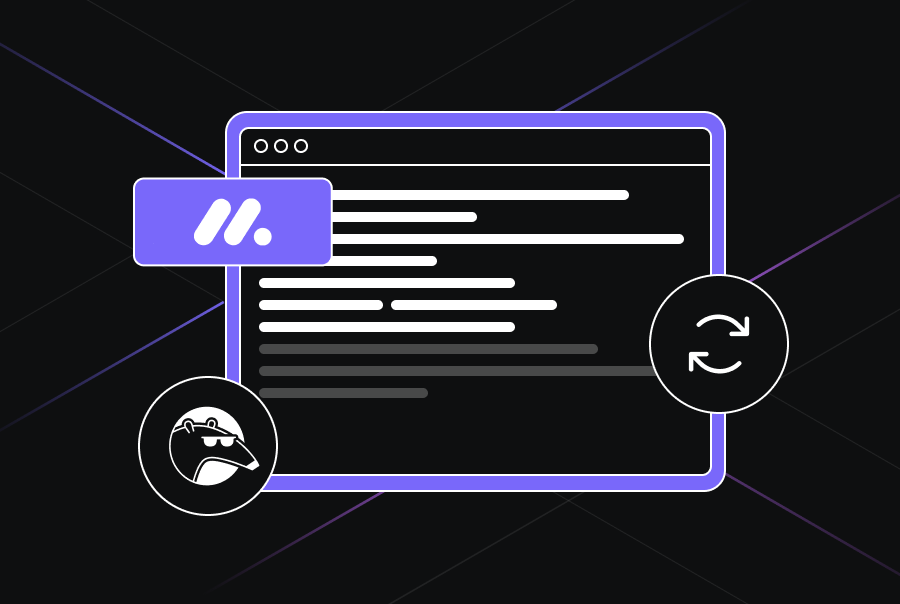Refactoring Frontend Code: Turning Spaghetti JavaScript into Modular, Maintainable Components


Frontend JavaScript projects can turn into spaghetti as they age. Complicated functions, unclear repository structures, and outdated dependencies all make it challenging to maintain your apps. It becomes difficult to understand what code is for or how it works. Legacy JavaScript patterns can also contribute to performance problems that slow down your user experience.
In this guide, we’re going to explore some key strategies for refactoring frontend JavaScript projects. You’ll learn how to modernize your code to improve its quality, concision, and maintainability.
The Problems with Spaghetti Frontend JavaScript
Frontend JavaScript is the code that’s shipped to browsers to make your web apps interactive. It can become spaghetti-like as your projects grow: different pages may individually load JavaScript files, each with their own dependency relationships. This means it’s often hard to discover all the conditions under which specific functions can run, while changes in one place can have knock-on impacts across the application—creating that unwanted spaghetti effect.
Legacy JavaScript code also commonly uses outdated libraries that don’t align with your project’s current technology stack. This creates inconsistencies that can lead to bugs and security issues. Developers may need to learn these brittle technologies before they’re able to update the code, causing an increase in change lead times.
Frontend JavaScript spaghetti is best solved by refactoring your legacy code. Refactoring is the process of iteratively improving code to reduce its complexity and improve maintainability. The code should still exhibit the same behavior before and after the refactor, but you can clean up its structure, adopt new language features, and improve modularity to make future updates easier.
How to Refactor Frontend Code?
The basic process of refactoring frontend JavaScript is similar to dealing with other types of legacy code. Use the following four steps to incrementally improve your projects:
- Identify Ineffective Areas of Code: Look for legacy code that’s hard to read, avoided by developers, or dependent on outdated technologies. Use AI agents to explain what the code does.
- Create or Expand the Code’s Test Suite: Ensure the code is covered by a robust test suite. Write missing test cases or use gen AI to automatically create them. Having good test coverage lets you check your refactored frontend code still outputs the correct results and produces the expected UI layout.
- Rewrite the Code’s Internals for Quality and Readability: Now’s the time to improve your code: try splitting it into reusable components, adopting modern JavaScript features, and fixing unclear naming conventions to make your repositories more maintainable. Use gen AI and IDE tools to automate the refactoring process based on best practices and your team’s style guide.
- Check Your Tests Still Pass: After you finish refactoring, run your full test suite to check the changes haven’t caused any regressions or unwanted side effects.
It’s also important to consider how frontend JavaScript interacts with the other technologies in your stack. For example, spaghetti JavaScript is often found alongside complex HTML structures and messy CSS files that are best tidied up at the same time. You should use end-to-end testing libraries to create visual snapshots of your interface before and after refactoring to verify that changes don’t affect what users see.
Best Practices for Refactoring Frontend JavaScript Code
Let’s take a closer look at the top techniques and best practices for refactoring frontend JavaScript projects. Applying these strategies as you refactor will let you turn your spaghetti code into neatly organized source that’s easy for developers to change in the future.
1. Adopt Component-Based Frameworks
Modern JavaScript libraries and frameworks like React and Vue model your user interfaces as modular components. You can also use native browser Web Components to implement similar functionality without adding any extra dependencies to your stack.
Components let you break your interfaces into smaller units that can be reused throughout your app. Each component includes the JavaScript to manage its state and behavior, alongside its HTML structure and CSS styles.
Component-based development makes large applications much more approachable. Developers can easily work on individual components in isolation, without having to untangle complex spaghetti scripts.
2. Keep Components as Small as Possible
Refactoring complex modules into smaller components reduces complexity and can make your code more readable. It can also enable new opportunities to reuse sections of code elsewhere in your app.
Look for opportunities to split your components as you refactor. For instance, the following React component renders both a menu bar and the items within the menu:
const Menu = ({
items,
onHideMenu
}) => {
return (
<div>
<button
onClick={onHideMenu}>
Hide Menu
</button>
<ul>
{
items.map((i, key) => (
<button
disabled={disabled}
key={key}
onClick={i.onClick}
style={{display: (i.disabled ? "none" : "block")}}>
{i.label}
</button>
))
}
</ul>
</div>
);
};
Splitting the item rendering code into a new component allows you to test that part of your interface independently:
const MenuItem = ({
item
}) => {
return (
<button
disabled={disabled}
key={key}
onClick={item.onClick}
style={{display: (item.disabled ? "none" : "block")}}>
{item.label}
</button>
);
};
const Menu = ({
items,
onHideMenu
}) => {
return (
<div>
<button
onClick={onHideMenu}>
Hide Menu
</button>
<ul>
{
items.map((i, key) => (
<MenuItem
item={item}
key={key} />
))
}
</ul>
</div>
);
};
You can now reuse the MenuItem component within other parts of your app, such as a HorizontalMenu or DropdownMenu.
3. Use Component Libraries
Component libraries are collections of prebuilt frontend interface elements designed to drop into existing apps. Open-source libraries are available for popular JavaScript app frameworks like React, Vue.js, and plain Web Components. MUI and Chakra are two popular component libraries for React, for example.
Refactoring your app to use interface components from a library can help you remove excess boilerplate from your codebase. You can then concentrate on the unique parts of your project, instead of maintaining code to render basic buttons and menus. Prebuilt components can also reduce your testing burden and help you maintain compliance with accessibility requirements.
4. Remove Unused and Outdated Dependencies
Older frontend JavaScript code regularly includes unused or outdated dependencies. These can slow down load times and expose your users to bugs and security issues. It becomes harder for developers to maintain affected code because they must first identify which dependencies are actually necessary, then learn how they work.
Removing redundant dependencies is an easy way to start cleaning up your projects. Similarly, replace or remove outdated libraries that can be converted to more modern technologies instead. For instance, jQuery is commonly found in legacy projects, but many of its most commonly used features can now be easily replicated in plain JavaScript.
5. Maintain a Logical File Structure
How you organize your repositories can greatly affect your code’s maintainability. Before you start making changes to your code, check that your repository is logically structured using clear file and folder names. This will help future developers to explore your codebase and understand how components relate to each other.
Many developers structure repositories by grouping similar types of code together, such as by using components/, services/, and views/ folders. This can help illustrate your project’s architecture, but it also means the code for individual app features is spread across multiple folders. Component-based development is often easier to manage when code is rearranged by feature, with all the code specific to higher-level components like AddUsersView being stored in a single folder.
6. Write Frontend Tests
Writing unit tests as you refactor is crucial so you can validate that your code behaves the same before and after your changes. Use popular testing libraries like Jest to write your tests, then run them as you work. You can also use a CI/CD service such as GitHub Actions or Jenkins to enforce that code can’t merge if your tests fail.
Frontend code should also be protected by visual end-to-end tests. Tools such as Cypress load your apps in a real web browser, letting you test that your components render correctly. You can set up routines such as clicking a button and then validating the correct result appears. This type of testing lets you check that refactoring doesn’t affect what users actually see.
7. Merge Duplicated Code into Reusable Functions and Components
Developers may duplicate frontend JavaScript code across multiple files and modules. This is often symptomatic of other code quality issues, such as not using component-driven development or relying on outdated libraries that require similar inputs to be supplied in several places. This can make your codebase feel larger than it really is.
Refactor duplicated code by consolidating it into reusable functions stored in independent modules. Follow the DRY (Don’t Repeat Yourself) approach to identify repetitive areas of code and encapsulate them in a function. Add function parameters to support small customizations in the code’s behavior each time it’s used, but avoid creating functions with long parameter lists. This is often a sign that the function’s still doing too much work and should be split into smaller units.
The following code demonstrates how easily duplicated code can occur:
function renderTicketPrice(ticket) {
document.write(`Ticket Price: ${(ticket.Price / 100).toFixed(2)}`);
}
function renderMembershipPrice(membership) {
document.write(`Membership Price: ${(membership.Price / 100).toFixed(2)}`);
}
The price formatting code is the same in both functions so it can be easily lifted into its own function. If another product type is added in the future, it could then reuse the existing price formatting code. This ensures the new product type matches the format already used elsewhere in your app, eliminating a possible bug.
function formatPrice(price) {
return (price / 100).toFixed(2);
}
function renderTicketPrice(ticket) {
document.write(`Ticket Price: ${formatPrice(ticket.Price)}`);
}
function renderMembershipPrice(membership) {
document.write(`Membership Price: ${formatPrice(membership.Price)}`);
}
8. Apply Consistent Naming Conventions
Maintaining code quality requires clear naming of source files, classes, functions, and variables throughout your codebase. This is particularly important in frontend code where there’s also CSS classes and DOM attributes to consider.
Choose a naming convention, such as camelCase variable names and PascalCase class names, then stick to it throughout your project. Ensure names are descriptive so they accurately convey the purpose of each code symbol in your project.
Using verbose names like sendOrderConfirmationEmail() is often preferable to shorter alternatives like sendEmail() because this removes any ambiguity about what different functions are for. Anyone reading your code will be able to understand exactly what it’s intended to do.
9. Consciously Optimize Code for Readability
Improving readability should be one of your key refactoring aims. Continuing the previous point’s theme, code that’s optimized for readability is easier for developers to understand. This reduces cognitive load, making changes more accessible to new developers who takeover the project in the future.
Besides naming conventions, readability is affected by factors including module length, architectural patterns, and use of loops, nested blocks, and conditionals. Some long functions, nested loops, and complex conditions are inevitable in large-scale projects, but attempting to minimize them—typically by splitting affected code into a larger number of smaller functions—will improve your code’s readability and make it less visually daunting. Try replacing loops with array methods where practical.
10. Group Related Components into Dedicated Modules
Legacy frontend code often depends on either a few very long JavaScript files, or multiple files that are loaded using separate <script> tags. These classic architectures can make it harder for developers to effectively create and use sections of reusable code.
JavaScript modules are now broadly supported in all major browsers. Modules can directly import other modules, letting you encapsulate related functions and classes within independently maintainable files.
Here’s a brief example of using a JavaScript module that provides some simple mathematical functions:
// math.js
const add = (a, b) => (a + b);
const sub = (a, b) => (a - b);
export {add, sub};
// main.js
import {add} from "math.js";
document.addEventListener("click", () => alert(add(1, 2)));
main.js directly imports the math.js module, so math.js doesn’t need to be added as a <script> tag in your HTML file. You can simply reference the main.js file, ensuring you set the type="module" attribute to specify that it’s a JavaScript module.
<script type="module" src="main.js"></script>
11. Maintain Separation of Concerns Across DOM (HTML), Styling (CSS), and Scripting (JavaScript)
Frontend code is more than just JavaScript: you also need HTML and CSS to build your app’s interface. HTML defines your UI’s structure as markup, while CSS provides styling and JavaScript enables logic and interactivity. Maintaining separation of concerns between these components makes your code cleaner, shorter, and easier for developers to find.
In practical terms, this means keeping JavaScript and CSS out of your HTML files. Use HTML <script> and <link> tags to load your resources from separate files that you can maintain individually of each other. This is often a fairly easy first refactoring step, as you can begin by lifting existing HTML, CSS, and JavaScript sections from monolithic files into individual components.
Modern JavaScript frameworks often explicitly advocate the combination of CSS and JavaScript using a CSS-in-JS approach. This works in conjunction with frameworks like React and Vue to make it easier to style your components. CSS-in-JS can be a useful strategy when you follow your library’s best practices, but larger projects may still benefit from separate scoped CSS files loaded using a solution such as CSS Modules.
12. Use Agent-Powered AI to Automate Refactoring With Codebase Intelligence
Refactoring doesn’t have to be a manual task. AI agents like Qodo Gen understand your project’s context, enabling accurate automation of refactoring processes. Qodo Gen analyzes your code’s intent, then suggests refactored versions that align with your team’s internal standards. Step-by-step plans of the changes being made give you visibility into refactoring activity, letting you see what Qodo Gen is doing and why.
Agentic AI can also generate new test cases. Automated test case generation makes it quick and easy to validate correct functionality and fill in coverage gaps. This accelerates the refactoring process while reducing the risk of post-refactoring failures.
It’s safe to say that AI represents the future of large-scale refactoring workflows, but it’s still important to check suggestions will actually be maintainable long-term. Don’t accept suggestions that you don’t understand, as this defeats the point of refactoring. Similarly, you should ensure you document accepted suggestions so future developers are informed what the code is for.
13. Start Small, then Iterate
Refactoring works best when it’s approached iteratively. If you’re inheriting a legacy project, it’s easy to feel overwhelmed by a mountain of outdated dependencies, unclear variable names, and missing test cases. It’s not possible to deal with it all at once, so you should look for the smallest changes that will have the biggest impact on your project’s health and quality.
For example, simply splitting up large files into smaller modules, removing obviously unused dependencies, and deploying IDE and agentic AI tools to clean up misleading names can make existing spaghetti JavaScript feel much more approachable. Once the codebase has been freshened up, you can then more easily conduct a full code quality audit before you start actually changing code.
Conclusion: Use Iteration, Components and AI Agents to Refactor Your Frontend Code
Refactoring frontend code is the process of turning spaghetti JavaScript into neatly organized components that are easy to update and understand. It’s best to start small in localized areas of legacy code, then iterate on gradual code quality improvements. Ensure your code has comprehensive test coverage so you can detect regressions and prevent changes in how refactored code behaves.
Adopt AI-powered agents to accelerate your refactoring with automated code intelligence. Qodo Gen explains how code works and can generate new test cases and ready-to-use refactors. Qodo dynamically learns your team’s coding standards and best practices, ensuring generated code matches your project’s style. The agent can also flag untested code that appears in new PRs, letting you catch coverage gaps before they have the chance to cause a problem.
Get started with Qodo Gen for free or book a demo to see AI-powered refactoring in action.

